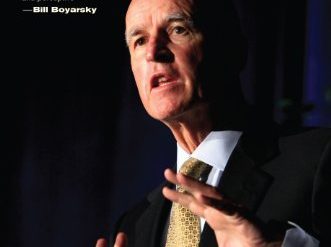
Since I was born six months before the U.S. entry into World War II, I grew up familiar with a long list of names — little-heard now, more than half a century later — that were associated with the U.S. role in the war. Remember, this was the war that seized hold of Planet Earth for a half-dozen years and set America’s course as a superpower for the balance of the 20th Century. Headlines and feature stories then celebrated the achievements of Jimmy Doolittle, Henry J. Kaiser, George Marshall, Hap Arnold, Curtis LeMay, Paul Tibbetts, and a host of others — every one of whom figures in the epic story so skillfully told in Freedom’s Forge. It’s the tale of how America came together in common purpose more powerfully than ever before or since.
As the book’s subtitle suggests, Freedom’s Forge focuses on the role that America’s business community, and especially Big Business, played in the monumental effort that resulted in the unconditional surrender of Germany and Japan just months apart in 1945. Two extraordinary men — William S. Knudsen and Henry Kaiser — are the stars of this story, business impresarios who marshaled the stupendous numbers of men and women and the unprecedented mountains of raw materials that supplied the U.S. and its Allies with the weapons of war.
Freedom’s Forge: How American Business Produced Victory in World War II by Arthur Herman (2012) 433 pages ★★★★★
Nothing since — not the Apollo moon landings, not the war in Vietnam, not even America’s protracted wars in Afghanistan and the Middle East — has come even remotely close to the magnitude of World War II. Over the five-year period from July 1940, when the U.S. began to rearm, until August 1945, when Japan surrendered, “America’s shipyards had launched 141 aircraft carriers, eight battleships, 807 cruisers, destroyers, and destroyer escorts, 203 submarines, and . . . almost 52 million tons of merchant shipping. Its factories turned out 88,410 tanks and self-propelled guns, 257,000 artillery pieces, 2.4 million trucks, 2.6 million machine guns — and 41 billion rounds of ammunition. As for aircraft, the United States had produced 324,750, averaging 170 a day since 1942.”
Can the human mind today even comprehend what must have been involved in manufacturing 300,000 airplanes and 100 aircraft carriers?
A staggering output of weapons
This staggering output of weapons came as a result of a profound transformation of the American economy, engineered in significant part by Bill Knudsen and Henry Kaiser. The two could hardly have been more different, and they didn’t like each other. Knudsen was a modest and unassuming Danish immigrant who worked closely with Henry Ford on the Model T and later built and ran General Motors into the world’s largest industrial corporation, dwarfing Ford’s output. Kaiser, a West Coast construction magnate who was the son of German immigrants, was flashy, outgoing, and immoderately persuasive — a model of self-promotion. Together with a host of others in and out of government, these two men led the conversion of the U.S. economy to unparalleled heights as the “arsenal of freedom.” Nonetheless, “[i]n 1945 Americans ate more meat, bought more shoes and gasoline, and used more electricity than they had before Hitler invaded France.”
Though I thoroughly enjoyed reading Freedom’s Forge, there was one discordant note. Author Arthur Herman, a free-market conservative who wrote this book as a visiting scholar at the right-wing American Enterprise Institute, advanced a political message throughout. That message could be summed up as “FDR, the New Deal, labor unions — bad. Business, businessmen, military leaders — good.” He could hardly have been more blatant. But the man writes well, and he did a stellar job of telling this unimaginably complex story between the covers of a single volume.
“A toast to American production”
In the conclusion, Herman quotes Josef Stalin when he first met at Tehran with Roosevelt and Churchill in 1943: he “raised his glass in a toast ‘to American production, without which this war would have been lost.’” There could be no higher praise for capitalism, coming as it did from the dictator of the Communist Soviet Union.
This review originally appeared in this blog in September 2012. I’m rerunning it here at a time of deep divisions in American society to remind us all that we have found common purpose throughout much of our history.
For related reading
This is one of My 10 favorite books about business history.
For a different view of the American mobilization, see The Washington War: FDR’s Inner Circle and the Politics of Power That Won World War II by James Lacey (The chaos within FDR’s inner circle during World War II).
You’ll find this book listed on my post, 10 top nonfiction books about World War II and in The 10 most memorable nonfiction books of the decade.
You might also enjoy The 10 best novels about World War II. And check out The 10 most consequential events of World War II and 30 good books about the Holocaust.
And you can always find my most popular reviews, and the most recent ones, on the Home Page.



























